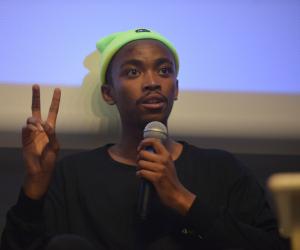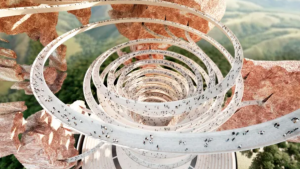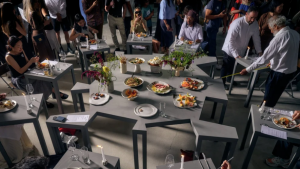Whose voices represent half of the world’s population? Those born in 1989 and later.
They are only now beginning to be heard and made more prolific by the digital age which also so happened to come about in 1989 with the creation of the World Wide Web. Many things changed around the globe, and in South Africa it was on the cusp of finally becoming free and democratic in 1994.
Mapping what motivates and informs their practice, and how they innovate as digital natives for the Cape Town inaugural 89plus post panel at Design Indaba 2014, we now introduce visual artist and participant Bogosi Sekhukhuni.
Together with 89plus co-founders Hans Ulrich Obrist, and Simon Castets and myself, Missla Libsekal (Another Africa founder) we talked with Bogosi, a digital native belonging to 50% of South Africa’s median age group.
Bogosi candidly shares his resonating insights on topics addressing the burdens of a broken past, the black body, self-awareness and the growing restlessness amongst South Africans.
If your work could be described by keywords what would they be?
Bogosi Sekhukhuni | Sincere? Eddie Murphy’s leather X- Men two piece in Raw? I’m not sure yet, I know that I’ve always been attracted to the universes that are opened up by ‘brokenness’. I like to break things, it’s a really fulfilling learning strategy (although it has its setbacks).
How did you come to art?
When I was 8 years old my mother would make me spend my school holiday days writing poetry for her inspection at the end of the day. She also took me to Ghana and I remember being gifted with a 2pac bootleg cassette tape of hits, the cassette was a sickly pink, that was around when I started taking an interest in art and culture.
Within your contemporaries, whose work do you most relate to?
@tamilionaire @datbitchseyonce @cussgroup @SallyMathunzi @Hlaskokoko
How does location figure into your practice?
I try not to treat or consider location as an explicit visual concern of mine (unless it is). It’s become quite fashionable in its literalness, I’m more interested in understanding and expressing subtle studies of my environment that are lived rather than analysed.
How does the virtual experience play into your work?
I’ve been having dreams about internet experiences, and waking up the next day thinking about a ‘notification’ that didn’t actually ‘happen’. An earlier aspect of the Dream Diary videos was to satisfy an interest in the closing gaps in our perceptions of what constitutes as everyday reality. I met my father for the first time through social media in 2012.
How would you describe your relationship to online socialization, and do you see it playing a part in your work?
I’ve become disillusioned by the apparent promise of social media, I wonder if it’s not just a really effective monitoring system, I think we need to figure out a new way to do all this, once kids start to teach themselves the mechanics that house the internet, maybe we’ll create altered internets? Or maybe we need to take things back to the anonymity of Mxit, Mxit was the first youth revolution post Y2K.
You’ve been working on understanding ‘information as a self organising consciousness; the inter exchange between virtual experiences and physical lives? What does this look like in your practice? Any epiphanies?
As part of my drawing practice, I plan on sequencing my DNA and printing out the code as a copy of myself. I have been interested in the idea presented by geneticists; who break down the building blocks of life as a digital code, that information organised in a particular way can amount to something with the potential to live/be conscious.
What digital platforms do you employ in your artistic expression?
Next month I will be exhibiting gifs developed from scenes from some of the Dream Diary videos.
What project would you like to realise one day?
I want to build my own RDP House.
What is your plan for the next 10 years?
I have been voraciously consuming information about humanity and I’m interested in continuing to study the history of human thinking. I ‘m really interested in set design and cinema and its relation to installation, I want to make a film about an ancestor of mine, who fought 11 battles against the Boers.
How does mythology factor into your work? What particular mythologies influence you? How do these mythologies interact with the contemporary culture in which you live?
I don’t subscribe to any mythologies, I’m more interested in inventing myself anew in this real but fantastical world. I don’t think Black people need mythologies right now, China is on the moon, India is on her way to Mars. We need a renewed and imaginative sense of self that exists and reflects our role in history.
The future is…
The future is right now, people don’t realise that we are very much actually living in the future.
How can art be used to re-imagine identity and why is this important to the cultural identity of South Africa today and to you as a South African individual?
I think art has a responsibility to help introduce a radical interpretation of self awareness that is engineered by its circumstances, particularly for Black and Brown people or whatever. Historically, representation in media and culture has played a role in forging a set of negative archetypes around the Black body that desperately needs to be reversed, for instance, I think not recognising yourself in the image of 99% of all fictional heroes or positive role models one is exposed to growing up must have some kind of impact on one’s sense of self?
How are global, Western or European culture affecting or manifesting in South Africa today? How are you exploring this in your practice?
Aspirational living has a particular face in South Africa and I would imagine, other postcolonial societies, it is a vicious blend of foreign cultural references and their local interpretations, producing an aesthetic with a solid and engaging character. The face of success in South Africa is influenced by the influx of Western popular culture content in our visual culture.
You have not shied away from criticizing the so called ‘Rainbow Nation.’ What kind of response has your work elicited? (for example ‘Fukin’ Ridiculous, a public performance piece with Sabelo Goma, that used businessman Kenny Kunene’s fondness for ‘Nyotaimori’ as a departure point)?
The response has always been positive, there is an increasing restlessness amongst South Africans who feel disillusioned with where our democracy is. I tried to reach out to Kenny Kunene, I had no money and wanted him to pay my school fees maybe. A lot of people read the performance as being critical of affluent black lifestyles but I’m not really interested in passing judgement on other people, the conversation was directed at what I saw as an interesting act of cultural appropriation.
www.anotherafrica.net/art-culture/89plus-bogosi-sekhukhuni-2










